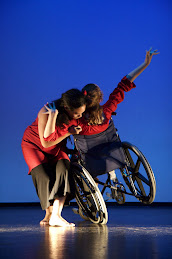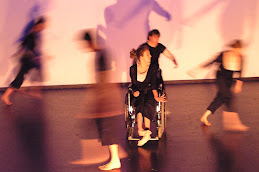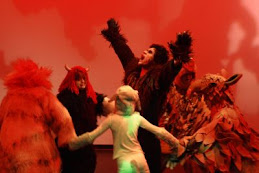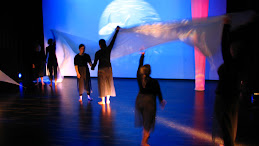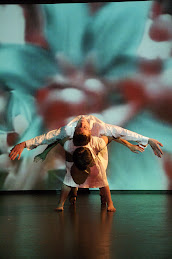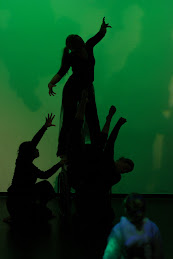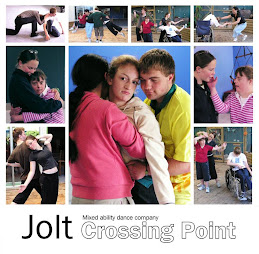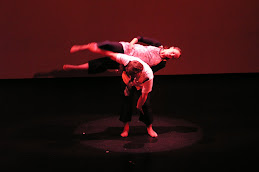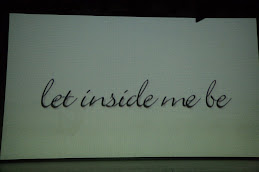There are three main terms that are used to describe a dance group that includes people with and without disabilities, the first is 'mixed ability', the second is 'integrated' and the third is 'inclusive'. All attempt to describe the unique mix of people that are included the dances. On describing the Touch Compass group Powles (2007) states "All members of the company have different levels of functionality, but the levels of skill and talent of all the company members are of a professional and extraordinary level" (p. 9). Mixed ability dance in New Zealand is still a relatively new thing; but it is developing. SPARC's "No Exceptions" Strategy highlights the need for inclusive leisure, sporting and recreational activities.
Lyn Cotton director of Jolt sums up the impact of mixed ability dance
"While dance provides new opportunities for people with disabilities to express themselves, in the same respect the involvement of people with disabilities in dance has created a new and powerful medium of expression. It challenges our perceptions of what dance is and in many ways what beauty is" (Kopytko, 2008, p 1).
References:
Kopytko, T. (2008). Jolt-mixed ability dance in Christchurch. DANZ Quarterly, 11. (Electronic Version).
Powles, M. (2007). Touch Compass: Celebrating integrated dance. Auckland:David Ling Publishing Ltd.
Saturday, August 30, 2008
Friday, August 29, 2008
Dance Movement Therapy in Occupational Therapy Literature
In searching specific Occupational Therapy Literature I found examples of Occupational Therapists working alongside Dance Therapists. Dance movement therapy within a medical/ health care system is traditionally used as an arts therapy within mental health settings. Dance Therapy emerged in the 1940/50's and is defined as "psychotheraputic use of movement as a process which furthers the emotional and physical integration of the individual" (Stanton, 1991, p. 108). Dance is considered to be a medium in which emotions can be expressed without the need for verbalisation. This insight into emotions can further a therapists understanding of the clients personality, developmental level and emotional responses to different stimuli. Stanton (1991) suggests that Occupational Therapists can play a co-leading role in dance therapy sessions to get a thorough insight into their clients. Dance movement therapy works under the belief that "the mind and body are inseparable" (Levy, 1998, p.1) and that "body movement reflects inner emotional states and that changes in movement behaviour can lead to changes in the psyche, thus promoting health and growth" (Levy, 1998, p. 1). A good example of dance therapy in action was the use of Dance and Occupational Therapy sessions with New York firefighters post 9/11. The Dance and Occupational Therapist faced similar challenges with getting the firefighters to engage in therapy and they were able to work together to achieve their goals of therapy (Cordero, 2006). The goals of Mixed ability dance are based around integration of the disability sector and do not address mental health issues. However the use of similar generic dance techniques are used in Mixed Ability Dance.
References:
Cordero, J., Zimbelmann, C. (2006). Counselling firefighters post 9/11 an occupational and dance movement therapists interventions and experiences. Occupational Therapy in Mental Health, 21 (3/4) 29-53.
Levy, F. J. (1998). Dance movement therapy: A healing art. USA: American Alliance for Health, physical education, recreation, and dance.
Stanton, K. (1991). Dance movement therapy: An introduction. British Journal of Occupational Therapy, 54 (3), 108-10.
References:
Cordero, J., Zimbelmann, C. (2006). Counselling firefighters post 9/11 an occupational and dance movement therapists interventions and experiences. Occupational Therapy in Mental Health, 21 (3/4) 29-53.
Levy, F. J. (1998). Dance movement therapy: A healing art. USA: American Alliance for Health, physical education, recreation, and dance.
Stanton, K. (1991). Dance movement therapy: An introduction. British Journal of Occupational Therapy, 54 (3), 108-10.
Review/ Summary of Literature

Reference: Hills, P. (2003). It's your move!: An inclusive approach to dance. Birmingham: The Questions Publishing Company Ltd.
This book introduces all the elements of inclusive dance. It is written in a way that person could pick it up and begin their own dance group using the information in the book. It highlights all the considerations that need to be made when working with people with special needs and their carers. Such as the equipment, the physical space, the support and education needed. The book uses examples of how you can adapt dance activities to all different people. Whether that's adapting your communication style or providing props to engage dancers. The book has activities and dance class plans that can be followed. In summary this book is a nice clear guide for leaders of integrated dance groups.
Review/ Summary of the Literature

Reference: Powles, M. (2007). Touch compass: Celebrating integrated dance. Auckland: David Ling Publishing Limited.
This book is a summary of the history of the Auckland based integrated dance company, Touch Compass. It walks through the development of the company, its dancers, the choreographers and the companies performance history. It is a beautifully presented book, packed with powerful images from the company and personal quotes from company members and journalists. The book really encompasses the joy of the dance. The company pushes the boundaries of what is possible for an integrated dance company. Achieving many great milestones, touring internationally and nationally, combining theatre, dance and even exploring the medium of video. The company combines people with and without disabilities on stage, using contact improvisation techniques to choreograph works. The company also uses aerial work to enable the dancers to take flight. Touch Compass runs workshops, taking their techniques and aerial equipment into the community so that more people can experience dance. The future direction of this company is to continue to produce professional works and expand dance into the community by providing training both to dancers and to teachers of dance.
The future direction of Touch Compass is all about enabling disabled people to participate in dance. Occupational Therapists can be part of this process by promoting, supporting, referring to and leading dance initiatives in their own work and communities. Infact I believe Occupational Therapists would be fanastic leaders of mixed ability dance groups. With their knowledge of biomechanics, disabilities, communcation skills, group facililation skills and the belief of the value of occupation and therefore dance.
This book is a summary of the history of the Auckland based integrated dance company, Touch Compass. It walks through the development of the company, its dancers, the choreographers and the companies performance history. It is a beautifully presented book, packed with powerful images from the company and personal quotes from company members and journalists. The book really encompasses the joy of the dance. The company pushes the boundaries of what is possible for an integrated dance company. Achieving many great milestones, touring internationally and nationally, combining theatre, dance and even exploring the medium of video. The company combines people with and without disabilities on stage, using contact improvisation techniques to choreograph works. The company also uses aerial work to enable the dancers to take flight. Touch Compass runs workshops, taking their techniques and aerial equipment into the community so that more people can experience dance. The future direction of this company is to continue to produce professional works and expand dance into the community by providing training both to dancers and to teachers of dance.
The future direction of Touch Compass is all about enabling disabled people to participate in dance. Occupational Therapists can be part of this process by promoting, supporting, referring to and leading dance initiatives in their own work and communities. Infact I believe Occupational Therapists would be fanastic leaders of mixed ability dance groups. With their knowledge of biomechanics, disabilities, communcation skills, group facililation skills and the belief of the value of occupation and therefore dance.
Monday, August 25, 2008
Review / Summary of the Literature
Reference: Kaufmann, K. A. (2006). Inclusive creative movement and dance. USA: Human Kinetics.
This book looks at the place of inclusive dance within the classroom, focusing on the benefits for students without and with disabilities. It is written for teachers and includes how dance can fit into the curriculum and suggests classroom reflection activities. Kaufmann (2006) states a large range of benefits that inclusive dance creates. This is just a few: flexibility, balance, basic motor skills, listening skills, imagination, creativity, memory and group work strategies (for example taking turns). “In inclusive dance, all students gain a sense of their own talents and learn to appreciate the rich, diverse world in which they live” (p.30). The book goes on to describe dance exercise examples. This book helps to explain the reasons why dancers are involved, when the associated benefits are many.
From an Occupational Therapy perspective the stated benefits of inclusive dance mirror many of the skills and areas that Occupational Therapists work with their clients on. Perhaps instead of a standard technique an Occupational Therapist should explore the possibilities of dance when working with clients.
This book looks at the place of inclusive dance within the classroom, focusing on the benefits for students without and with disabilities. It is written for teachers and includes how dance can fit into the curriculum and suggests classroom reflection activities. Kaufmann (2006) states a large range of benefits that inclusive dance creates. This is just a few: flexibility, balance, basic motor skills, listening skills, imagination, creativity, memory and group work strategies (for example taking turns). “In inclusive dance, all students gain a sense of their own talents and learn to appreciate the rich, diverse world in which they live” (p.30). The book goes on to describe dance exercise examples. This book helps to explain the reasons why dancers are involved, when the associated benefits are many.
From an Occupational Therapy perspective the stated benefits of inclusive dance mirror many of the skills and areas that Occupational Therapists work with their clients on. Perhaps instead of a standard technique an Occupational Therapist should explore the possibilities of dance when working with clients.
Review/ Summary of the Literature

Reference: Wethered, A. G. (1993). Movement and drama in therapy: A holistic approach (2nd ed.). London: Jessica Kingsley Publishers Ltd.
This book looks at the therapeutic possibilities of movement and drama. Wethered has based her approach as a specialist in this line of therapy around Rudolf Laban’s approach to movement. That is exploring of concepts of weight, speed, tension and levels. The book really focused on the therapeutic nature of dance and drama. Wethered uses drama and movement as a means for patients to express emotions and deal with traumatic histories. Wethered suggests using life examples and situations and then asks clients to reflect verbally on the experience to gain an understanding on the emotions and thoughts the client may have about a sensitive subject. The book uses a variety a practical examples, case studies and research projects to illustrate the use of movement and drama with different client groups. A clear easy read and a good introduction to movement and drama therapy.
This book looks at the therapeutic possibilities of movement and drama. Wethered has based her approach as a specialist in this line of therapy around Rudolf Laban’s approach to movement. That is exploring of concepts of weight, speed, tension and levels. The book really focused on the therapeutic nature of dance and drama. Wethered uses drama and movement as a means for patients to express emotions and deal with traumatic histories. Wethered suggests using life examples and situations and then asks clients to reflect verbally on the experience to gain an understanding on the emotions and thoughts the client may have about a sensitive subject. The book uses a variety a practical examples, case studies and research projects to illustrate the use of movement and drama with different client groups. A clear easy read and a good introduction to movement and drama therapy.
Review/ Summary of Literature

Reference: Guthrie, J., & Roydhouse, J. (1988). Come and join the dance: A creative approach to movement for children with special needs. Australia: Hyland Huse Publishing Pty Ltd.
This book looks at how to provide a dance programme for children with special needs under the age of five. Using the four basic elements of dance: space, force, time and flow, the dance programmes can "stimulate growth and learning" (p. 28). It also promotes increased flexibility, balance, motor skills, strength, body awareness and helps to develop rhythm. The approach is very directive, with the caregivers and leaders initiating the movement for the children, the group is for the child and caregiver. There is a large hands on element to the dance activities with the children being lifted, carried and handled through different movements. The use of music is also considered and the playing of instruments is combined into the dance class. The book also includes a programme for readers to follow that includes instructions for activities.
This book looks at how to provide a dance programme for children with special needs under the age of five. Using the four basic elements of dance: space, force, time and flow, the dance programmes can "stimulate growth and learning" (p. 28). It also promotes increased flexibility, balance, motor skills, strength, body awareness and helps to develop rhythm. The approach is very directive, with the caregivers and leaders initiating the movement for the children, the group is for the child and caregiver. There is a large hands on element to the dance activities with the children being lifted, carried and handled through different movements. The use of music is also considered and the playing of instruments is combined into the dance class. The book also includes a programme for readers to follow that includes instructions for activities.
This type of dance application has parallels with Paediatric Occupational Therapy approaches such as the neurodevelopmental and sensory integration. It uses guided movement and provides sensory experiences to children with special needs and includes the important aspect of educating the parents and caregivers.
Sunday, August 24, 2008
Relevant Links- Mixed ability dance groups
Jolt
Check out the home page for Jolt, you can find general information about the group, profiles of company members and images from the shows over the last 7 years. http://www.joltdance.co.nz/
Touch Compass
Touch Compass a mixed ability dance company based in Auckland that has produced some fantastic dance shows that have toured the country. The company is known for their professional, and challenging performances and they also do some amazing aerial work.
http://www.touchcompass.org.nz/
Amici Dance Theatre Company
This London based mixed ability group has toured worldwide and the philosophy of Amici has heavily influenced Jolt.
http://www.amicidance.org/
DANZ
Linked is an article journal of an interview with Lyn Cotton, director and creator of Jolt. It expresses the key concepts and influences of Jolt, its history and the future aspirations of the group
http://www.danz.org.nz/Magazines/DQ/Apr08/jolt.php
Check out the home page for Jolt, you can find general information about the group, profiles of company members and images from the shows over the last 7 years. http://www.joltdance.co.nz/
Touch Compass
Touch Compass a mixed ability dance company based in Auckland that has produced some fantastic dance shows that have toured the country. The company is known for their professional, and challenging performances and they also do some amazing aerial work.
http://www.touchcompass.org.nz/
Amici Dance Theatre Company
This London based mixed ability group has toured worldwide and the philosophy of Amici has heavily influenced Jolt.
http://www.amicidance.org/
DANZ
Linked is an article journal of an interview with Lyn Cotton, director and creator of Jolt. It expresses the key concepts and influences of Jolt, its history and the future aspirations of the group
http://www.danz.org.nz/Magazines/DQ/Apr08/jolt.php
A personal Reflection: What Jolt means to me

I first joined Jolt in 2004, and it has made a huge impression on my life. I began first just attending the classes and quickly found myself in my first show. I then supported an individual dancer at the Monday night class and now I am an assistant tutor for Jolt- Dunedin. Jolt has become an extended family and has challenged my view of disability and it has shown me the beauty of dance. I still struggle with calling myself a "dancer" but I will happily call myself a Jolt dancer. Jolt has provided me with the opportunity to explore my own dance abilities and has given me a way to extend my performance skills. But Jolt is so much more than just going on stage, in Jolt you are not just one dancer on the stage, you are just one part of a support net that holds all the dancers together. The dancers, families and leaders of Jolt have an amazing ability to embrace and support each other; both within the classes and shows and outside of them. Jolt continually challenges me. As a tutor my challenge is to encourage the dancers to extend beyond their current movements and bring out their beauty, strengths, individuality and showcase them to the world. Dance is such a unique medium in which language and physical restrictions are not boundaries. Jolt means so much to me and I don't have a disability. I love Jolt because of the philosophy of inclusion. I love that the group is about embracing what a person does have. It is not a group of people with disabilities, it is a group of people who have different abilities to each other and to other dance groups
Subscribe to:
Posts (Atom)

